Inditex Strategic Management Report: Analysis, Evaluation & Actions
VerifiedAdded on 2023/06/12
|11
|2353
|179
Report
AI Summary
This report provides a comprehensive strategic analysis of Inditex, a global Spanish fashion retailer, utilizing SWOT and TOWS matrices to evaluate its current strategies and identify key strategic issues. The analysis covers Inditex's strengths in brand recognition, fashion trend adaptation, and customer communication, while also addressing weaknesses such as supply chain challenges and the perceived value of its brands. The report evaluates MNE strategies, vertical integration, market development, and differentiation strategies, highlighting challenges related to low in-store inventory, quality perceptions, and local transportation costs. Recommendations include improving supply chain management through RFID technology, adopting a cost leadership strategy, and enhancing customer perceived value through promotional events and online marketing. The report concludes by emphasizing the importance of addressing these strategic issues to ensure Inditex's continued success and growth in the global market. Desklib offers similar solved assignments and study tools for students.
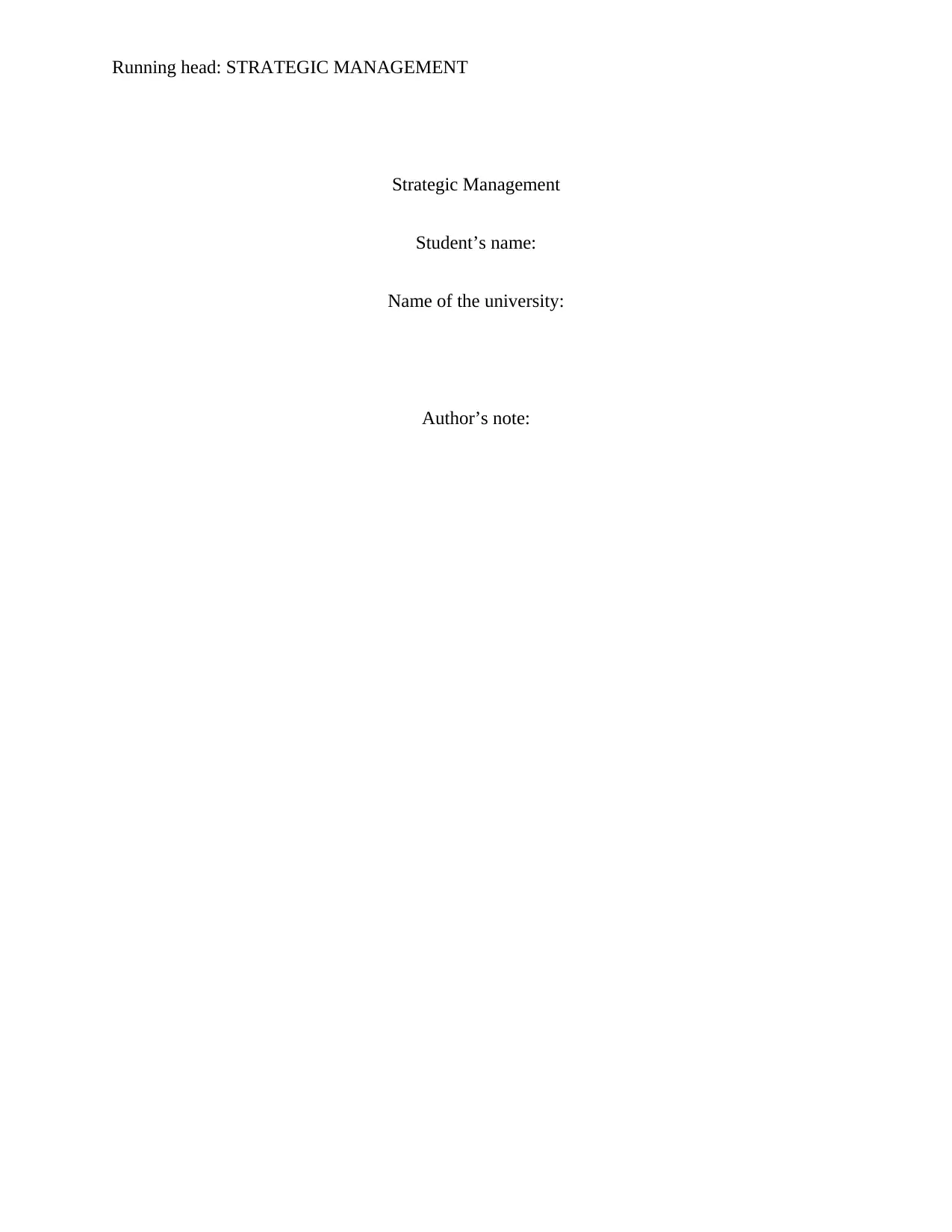
Running head: STRATEGIC MANAGEMENT
Strategic Management
Student’s name:
Name of the university:
Author’s note:
Strategic Management
Student’s name:
Name of the university:
Author’s note:
Paraphrase This Document
Need a fresh take? Get an instant paraphrase of this document with our AI Paraphraser
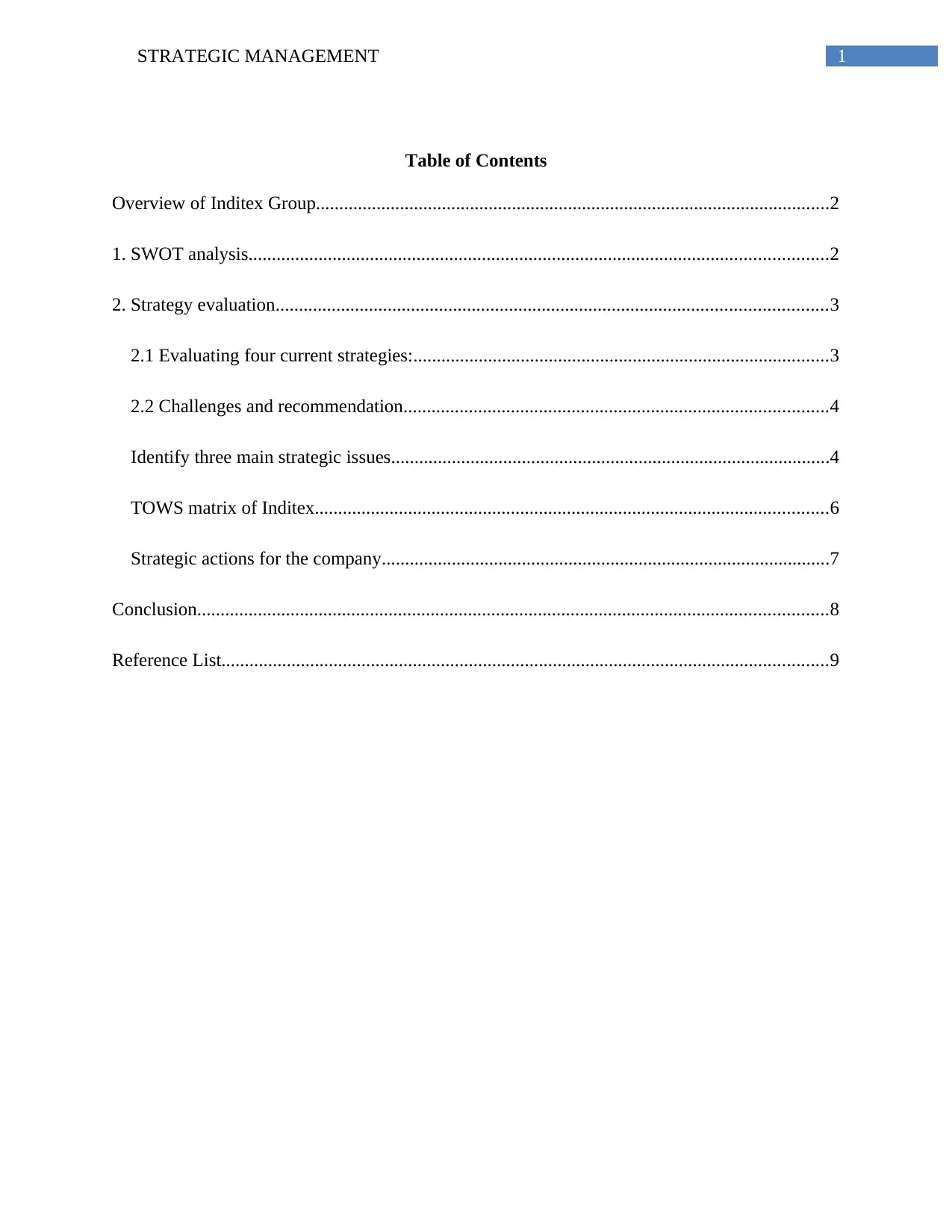
1STRATEGIC MANAGEMENT
Table of Contents
Overview of Inditex Group..............................................................................................................2
1. SWOT analysis............................................................................................................................2
2. Strategy evaluation......................................................................................................................3
2.1 Evaluating four current strategies:.........................................................................................3
2.2 Challenges and recommendation...........................................................................................4
Identify three main strategic issues..............................................................................................4
TOWS matrix of Inditex..............................................................................................................6
Strategic actions for the company................................................................................................7
Conclusion.......................................................................................................................................8
Reference List..................................................................................................................................9
Table of Contents
Overview of Inditex Group..............................................................................................................2
1. SWOT analysis............................................................................................................................2
2. Strategy evaluation......................................................................................................................3
2.1 Evaluating four current strategies:.........................................................................................3
2.2 Challenges and recommendation...........................................................................................4
Identify three main strategic issues..............................................................................................4
TOWS matrix of Inditex..............................................................................................................6
Strategic actions for the company................................................................................................7
Conclusion.......................................................................................................................................8
Reference List..................................................................................................................................9
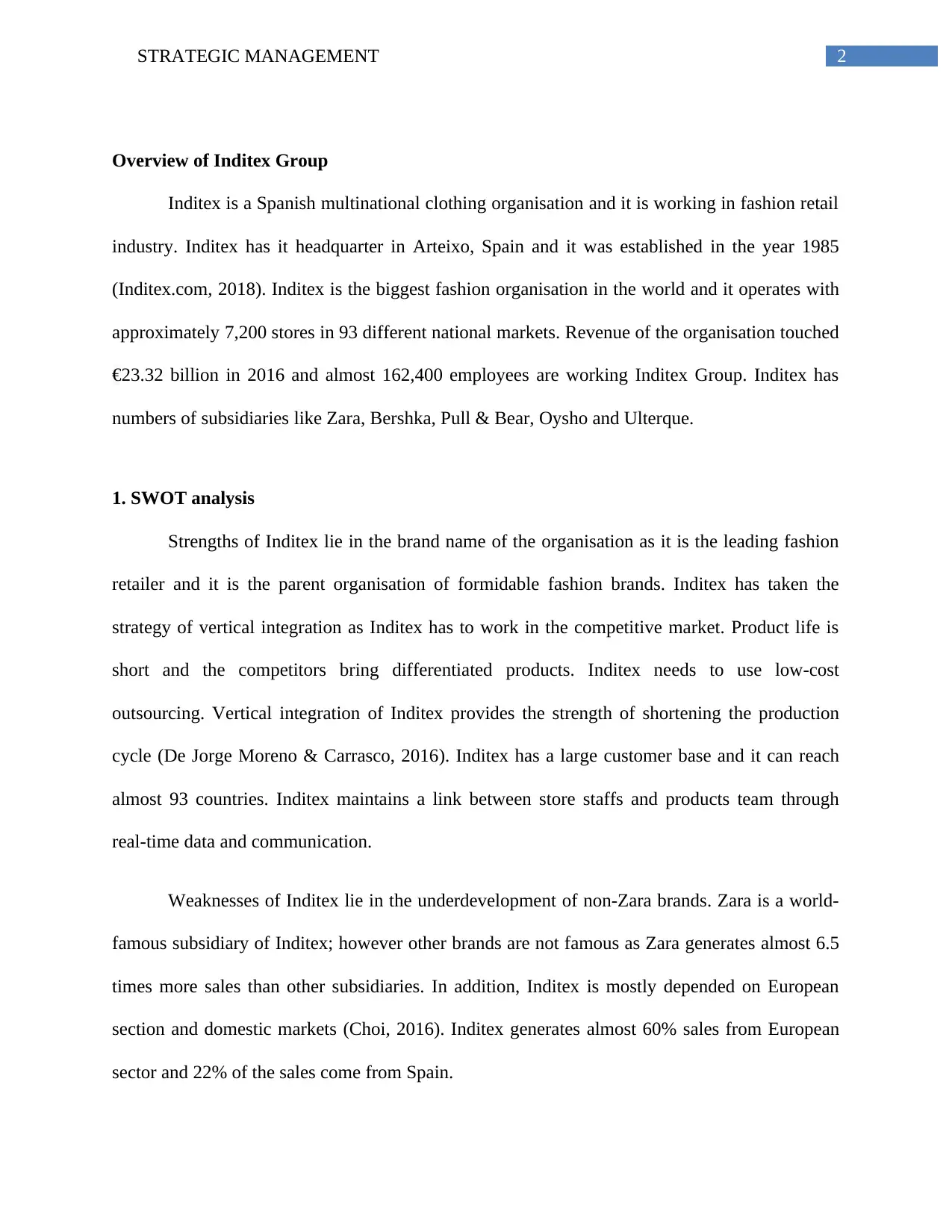
2STRATEGIC MANAGEMENT
Overview of Inditex Group
Inditex is a Spanish multinational clothing organisation and it is working in fashion retail
industry. Inditex has it headquarter in Arteixo, Spain and it was established in the year 1985
(Inditex.com, 2018). Inditex is the biggest fashion organisation in the world and it operates with
approximately 7,200 stores in 93 different national markets. Revenue of the organisation touched
€23.32 billion in 2016 and almost 162,400 employees are working Inditex Group. Inditex has
numbers of subsidiaries like Zara, Bershka, Pull & Bear, Oysho and Ulterque.
1. SWOT analysis
Strengths of Inditex lie in the brand name of the organisation as it is the leading fashion
retailer and it is the parent organisation of formidable fashion brands. Inditex has taken the
strategy of vertical integration as Inditex has to work in the competitive market. Product life is
short and the competitors bring differentiated products. Inditex needs to use low-cost
outsourcing. Vertical integration of Inditex provides the strength of shortening the production
cycle (De Jorge Moreno & Carrasco, 2016). Inditex has a large customer base and it can reach
almost 93 countries. Inditex maintains a link between store staffs and products team through
real-time data and communication.
Weaknesses of Inditex lie in the underdevelopment of non-Zara brands. Zara is a world-
famous subsidiary of Inditex; however other brands are not famous as Zara generates almost 6.5
times more sales than other subsidiaries. In addition, Inditex is mostly depended on European
section and domestic markets (Choi, 2016). Inditex generates almost 60% sales from European
sector and 22% of the sales come from Spain.
Overview of Inditex Group
Inditex is a Spanish multinational clothing organisation and it is working in fashion retail
industry. Inditex has it headquarter in Arteixo, Spain and it was established in the year 1985
(Inditex.com, 2018). Inditex is the biggest fashion organisation in the world and it operates with
approximately 7,200 stores in 93 different national markets. Revenue of the organisation touched
€23.32 billion in 2016 and almost 162,400 employees are working Inditex Group. Inditex has
numbers of subsidiaries like Zara, Bershka, Pull & Bear, Oysho and Ulterque.
1. SWOT analysis
Strengths of Inditex lie in the brand name of the organisation as it is the leading fashion
retailer and it is the parent organisation of formidable fashion brands. Inditex has taken the
strategy of vertical integration as Inditex has to work in the competitive market. Product life is
short and the competitors bring differentiated products. Inditex needs to use low-cost
outsourcing. Vertical integration of Inditex provides the strength of shortening the production
cycle (De Jorge Moreno & Carrasco, 2016). Inditex has a large customer base and it can reach
almost 93 countries. Inditex maintains a link between store staffs and products team through
real-time data and communication.
Weaknesses of Inditex lie in the underdevelopment of non-Zara brands. Zara is a world-
famous subsidiary of Inditex; however other brands are not famous as Zara generates almost 6.5
times more sales than other subsidiaries. In addition, Inditex is mostly depended on European
section and domestic markets (Choi, 2016). Inditex generates almost 60% sales from European
sector and 22% of the sales come from Spain.
⊘ This is a preview!⊘
Do you want full access?
Subscribe today to unlock all pages.

Trusted by 1+ million students worldwide
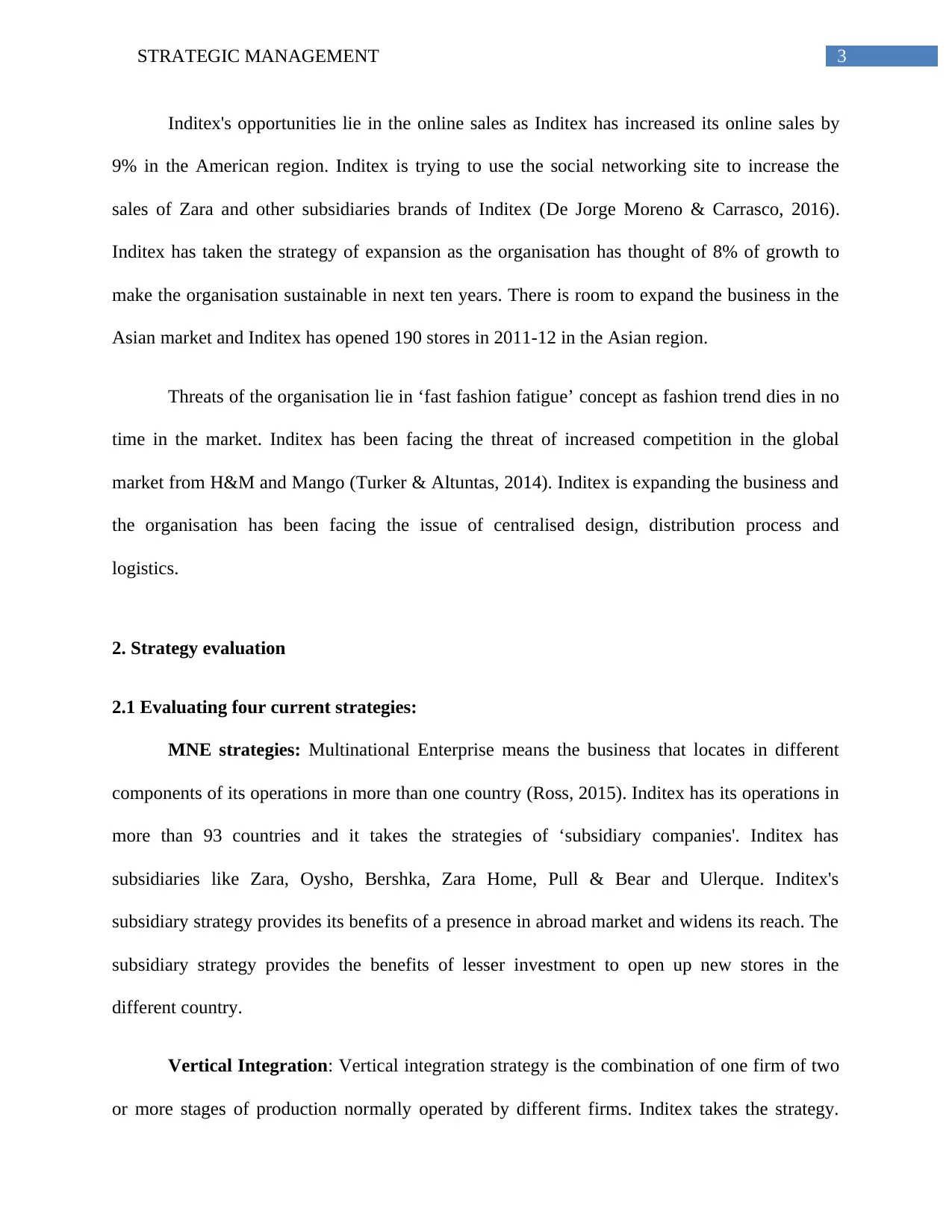
3STRATEGIC MANAGEMENT
Inditex's opportunities lie in the online sales as Inditex has increased its online sales by
9% in the American region. Inditex is trying to use the social networking site to increase the
sales of Zara and other subsidiaries brands of Inditex (De Jorge Moreno & Carrasco, 2016).
Inditex has taken the strategy of expansion as the organisation has thought of 8% of growth to
make the organisation sustainable in next ten years. There is room to expand the business in the
Asian market and Inditex has opened 190 stores in 2011-12 in the Asian region.
Threats of the organisation lie in ‘fast fashion fatigue’ concept as fashion trend dies in no
time in the market. Inditex has been facing the threat of increased competition in the global
market from H&M and Mango (Turker & Altuntas, 2014). Inditex is expanding the business and
the organisation has been facing the issue of centralised design, distribution process and
logistics.
2. Strategy evaluation
2.1 Evaluating four current strategies:
MNE strategies: Multinational Enterprise means the business that locates in different
components of its operations in more than one country (Ross, 2015). Inditex has its operations in
more than 93 countries and it takes the strategies of ‘subsidiary companies'. Inditex has
subsidiaries like Zara, Oysho, Bershka, Zara Home, Pull & Bear and Ulerque. Inditex's
subsidiary strategy provides its benefits of a presence in abroad market and widens its reach. The
subsidiary strategy provides the benefits of lesser investment to open up new stores in the
different country.
Vertical Integration: Vertical integration strategy is the combination of one firm of two
or more stages of production normally operated by different firms. Inditex takes the strategy.
Inditex's opportunities lie in the online sales as Inditex has increased its online sales by
9% in the American region. Inditex is trying to use the social networking site to increase the
sales of Zara and other subsidiaries brands of Inditex (De Jorge Moreno & Carrasco, 2016).
Inditex has taken the strategy of expansion as the organisation has thought of 8% of growth to
make the organisation sustainable in next ten years. There is room to expand the business in the
Asian market and Inditex has opened 190 stores in 2011-12 in the Asian region.
Threats of the organisation lie in ‘fast fashion fatigue’ concept as fashion trend dies in no
time in the market. Inditex has been facing the threat of increased competition in the global
market from H&M and Mango (Turker & Altuntas, 2014). Inditex is expanding the business and
the organisation has been facing the issue of centralised design, distribution process and
logistics.
2. Strategy evaluation
2.1 Evaluating four current strategies:
MNE strategies: Multinational Enterprise means the business that locates in different
components of its operations in more than one country (Ross, 2015). Inditex has its operations in
more than 93 countries and it takes the strategies of ‘subsidiary companies'. Inditex has
subsidiaries like Zara, Oysho, Bershka, Zara Home, Pull & Bear and Ulerque. Inditex's
subsidiary strategy provides its benefits of a presence in abroad market and widens its reach. The
subsidiary strategy provides the benefits of lesser investment to open up new stores in the
different country.
Vertical Integration: Vertical integration strategy is the combination of one firm of two
or more stages of production normally operated by different firms. Inditex takes the strategy.
Paraphrase This Document
Need a fresh take? Get an instant paraphrase of this document with our AI Paraphraser
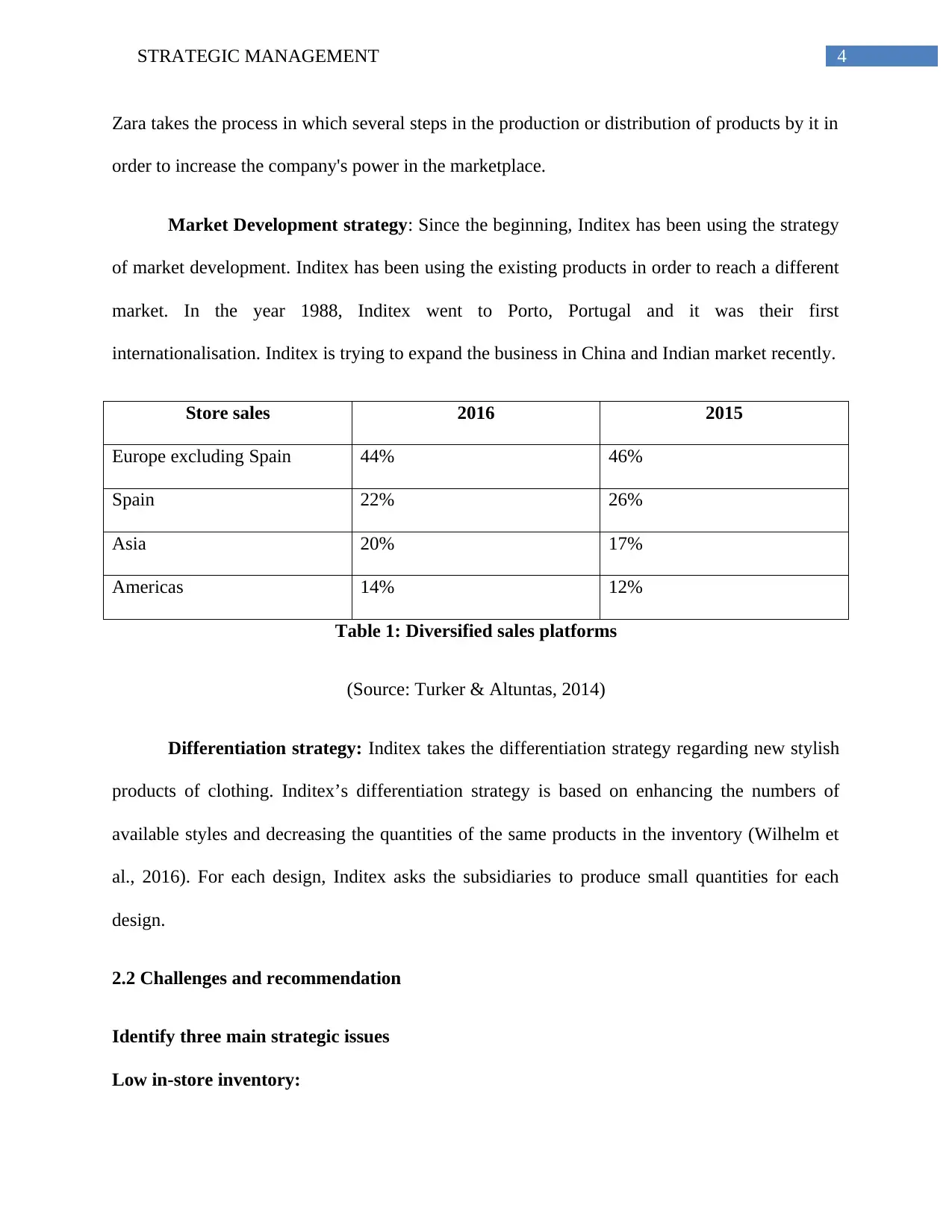
4STRATEGIC MANAGEMENT
Zara takes the process in which several steps in the production or distribution of products by it in
order to increase the company's power in the marketplace.
Market Development strategy: Since the beginning, Inditex has been using the strategy
of market development. Inditex has been using the existing products in order to reach a different
market. In the year 1988, Inditex went to Porto, Portugal and it was their first
internationalisation. Inditex is trying to expand the business in China and Indian market recently.
Store sales 2016 2015
Europe excluding Spain 44% 46%
Spain 22% 26%
Asia 20% 17%
Americas 14% 12%
Table 1: Diversified sales platforms
(Source: Turker & Altuntas, 2014)
Differentiation strategy: Inditex takes the differentiation strategy regarding new stylish
products of clothing. Inditex’s differentiation strategy is based on enhancing the numbers of
available styles and decreasing the quantities of the same products in the inventory (Wilhelm et
al., 2016). For each design, Inditex asks the subsidiaries to produce small quantities for each
design.
2.2 Challenges and recommendation
Identify three main strategic issues
Low in-store inventory:
Zara takes the process in which several steps in the production or distribution of products by it in
order to increase the company's power in the marketplace.
Market Development strategy: Since the beginning, Inditex has been using the strategy
of market development. Inditex has been using the existing products in order to reach a different
market. In the year 1988, Inditex went to Porto, Portugal and it was their first
internationalisation. Inditex is trying to expand the business in China and Indian market recently.
Store sales 2016 2015
Europe excluding Spain 44% 46%
Spain 22% 26%
Asia 20% 17%
Americas 14% 12%
Table 1: Diversified sales platforms
(Source: Turker & Altuntas, 2014)
Differentiation strategy: Inditex takes the differentiation strategy regarding new stylish
products of clothing. Inditex’s differentiation strategy is based on enhancing the numbers of
available styles and decreasing the quantities of the same products in the inventory (Wilhelm et
al., 2016). For each design, Inditex asks the subsidiaries to produce small quantities for each
design.
2.2 Challenges and recommendation
Identify three main strategic issues
Low in-store inventory:
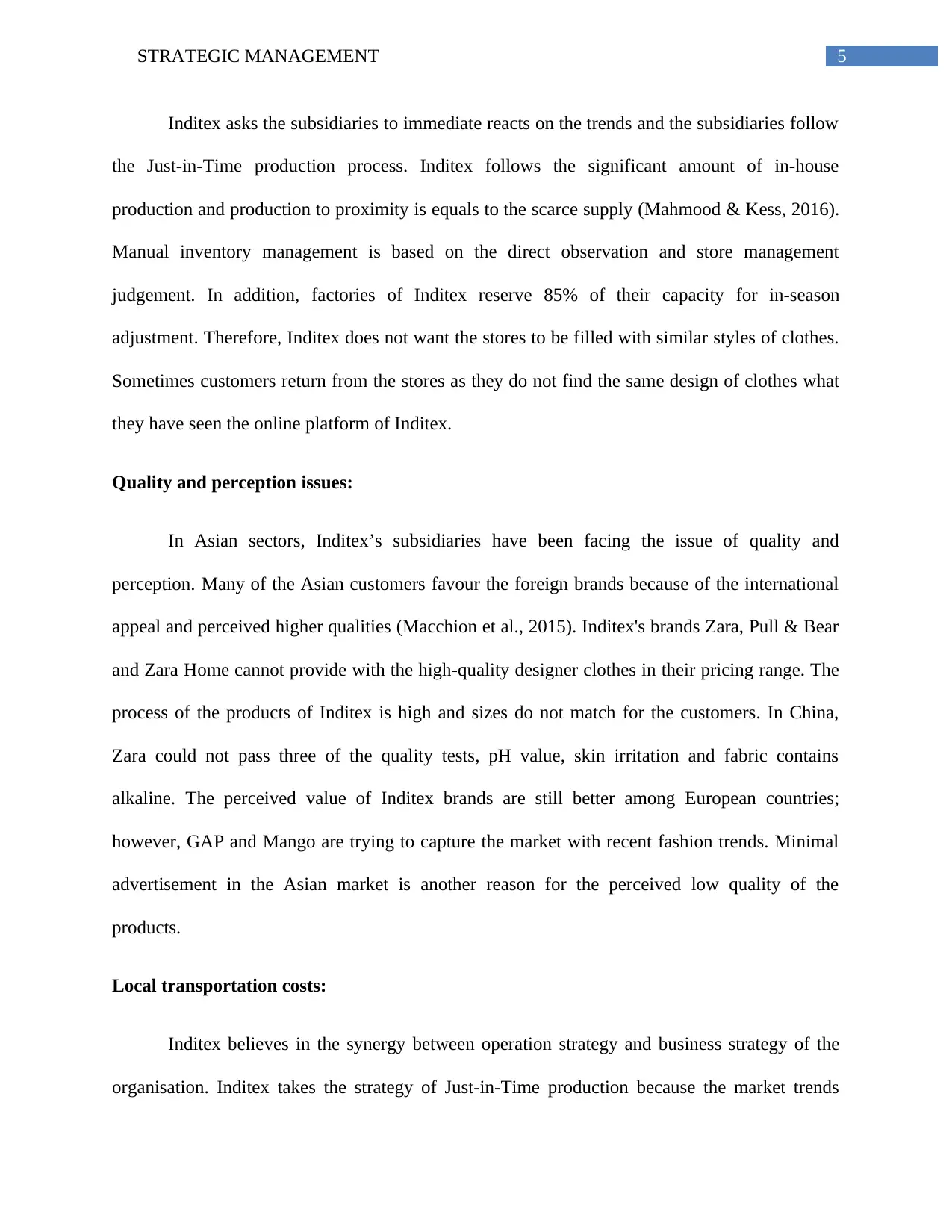
5STRATEGIC MANAGEMENT
Inditex asks the subsidiaries to immediate reacts on the trends and the subsidiaries follow
the Just-in-Time production process. Inditex follows the significant amount of in-house
production and production to proximity is equals to the scarce supply (Mahmood & Kess, 2016).
Manual inventory management is based on the direct observation and store management
judgement. In addition, factories of Inditex reserve 85% of their capacity for in-season
adjustment. Therefore, Inditex does not want the stores to be filled with similar styles of clothes.
Sometimes customers return from the stores as they do not find the same design of clothes what
they have seen the online platform of Inditex.
Quality and perception issues:
In Asian sectors, Inditex’s subsidiaries have been facing the issue of quality and
perception. Many of the Asian customers favour the foreign brands because of the international
appeal and perceived higher qualities (Macchion et al., 2015). Inditex's brands Zara, Pull & Bear
and Zara Home cannot provide with the high-quality designer clothes in their pricing range. The
process of the products of Inditex is high and sizes do not match for the customers. In China,
Zara could not pass three of the quality tests, pH value, skin irritation and fabric contains
alkaline. The perceived value of Inditex brands are still better among European countries;
however, GAP and Mango are trying to capture the market with recent fashion trends. Minimal
advertisement in the Asian market is another reason for the perceived low quality of the
products.
Local transportation costs:
Inditex believes in the synergy between operation strategy and business strategy of the
organisation. Inditex takes the strategy of Just-in-Time production because the market trends
Inditex asks the subsidiaries to immediate reacts on the trends and the subsidiaries follow
the Just-in-Time production process. Inditex follows the significant amount of in-house
production and production to proximity is equals to the scarce supply (Mahmood & Kess, 2016).
Manual inventory management is based on the direct observation and store management
judgement. In addition, factories of Inditex reserve 85% of their capacity for in-season
adjustment. Therefore, Inditex does not want the stores to be filled with similar styles of clothes.
Sometimes customers return from the stores as they do not find the same design of clothes what
they have seen the online platform of Inditex.
Quality and perception issues:
In Asian sectors, Inditex’s subsidiaries have been facing the issue of quality and
perception. Many of the Asian customers favour the foreign brands because of the international
appeal and perceived higher qualities (Macchion et al., 2015). Inditex's brands Zara, Pull & Bear
and Zara Home cannot provide with the high-quality designer clothes in their pricing range. The
process of the products of Inditex is high and sizes do not match for the customers. In China,
Zara could not pass three of the quality tests, pH value, skin irritation and fabric contains
alkaline. The perceived value of Inditex brands are still better among European countries;
however, GAP and Mango are trying to capture the market with recent fashion trends. Minimal
advertisement in the Asian market is another reason for the perceived low quality of the
products.
Local transportation costs:
Inditex believes in the synergy between operation strategy and business strategy of the
organisation. Inditex takes the strategy of Just-in-Time production because the market trends
⊘ This is a preview!⊘
Do you want full access?
Subscribe today to unlock all pages.

Trusted by 1+ million students worldwide
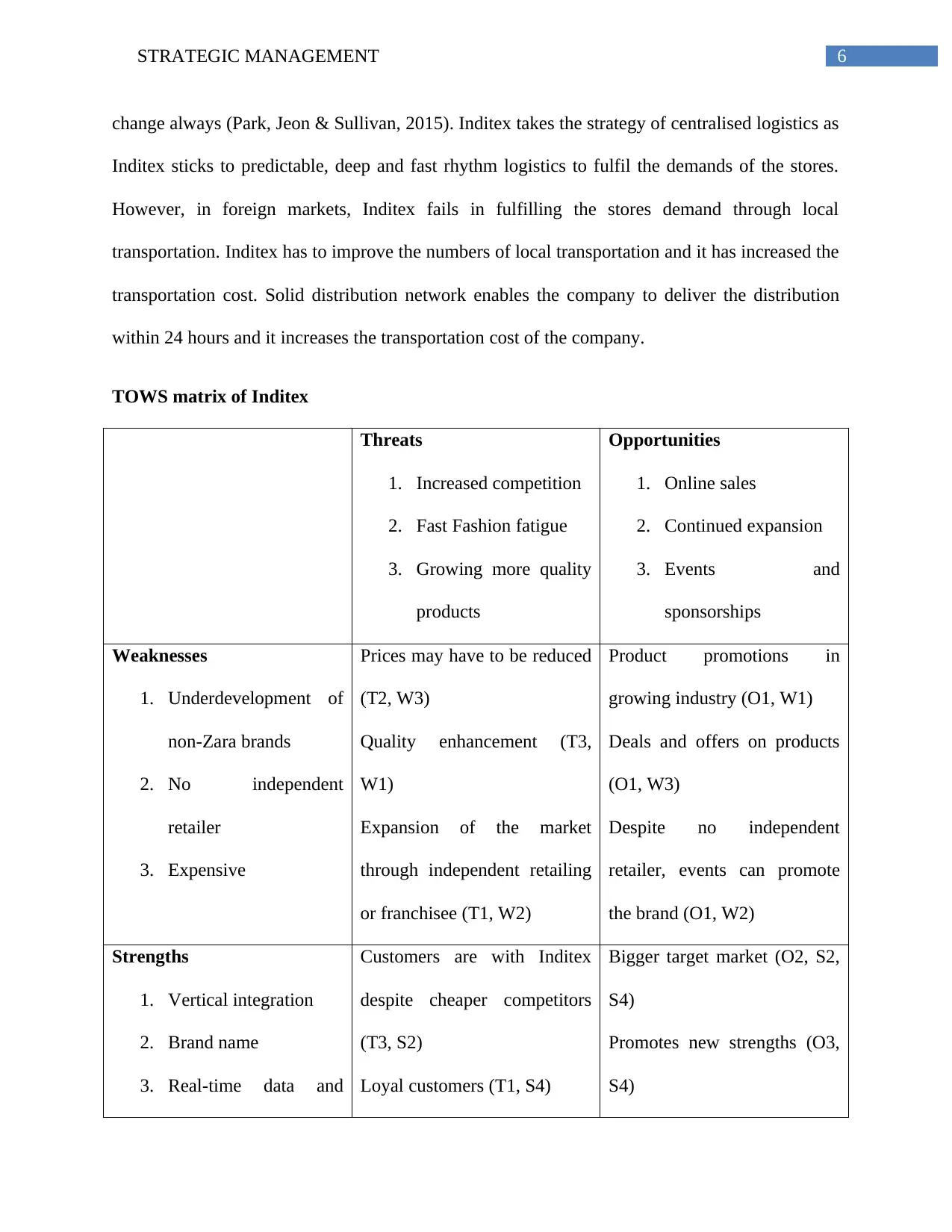
6STRATEGIC MANAGEMENT
change always (Park, Jeon & Sullivan, 2015). Inditex takes the strategy of centralised logistics as
Inditex sticks to predictable, deep and fast rhythm logistics to fulfil the demands of the stores.
However, in foreign markets, Inditex fails in fulfilling the stores demand through local
transportation. Inditex has to improve the numbers of local transportation and it has increased the
transportation cost. Solid distribution network enables the company to deliver the distribution
within 24 hours and it increases the transportation cost of the company.
TOWS matrix of Inditex
Threats
1. Increased competition
2. Fast Fashion fatigue
3. Growing more quality
products
Opportunities
1. Online sales
2. Continued expansion
3. Events and
sponsorships
Weaknesses
1. Underdevelopment of
non-Zara brands
2. No independent
retailer
3. Expensive
Prices may have to be reduced
(T2, W3)
Quality enhancement (T3,
W1)
Expansion of the market
through independent retailing
or franchisee (T1, W2)
Product promotions in
growing industry (O1, W1)
Deals and offers on products
(O1, W3)
Despite no independent
retailer, events can promote
the brand (O1, W2)
Strengths
1. Vertical integration
2. Brand name
3. Real-time data and
Customers are with Inditex
despite cheaper competitors
(T3, S2)
Loyal customers (T1, S4)
Bigger target market (O2, S2,
S4)
Promotes new strengths (O3,
S4)
change always (Park, Jeon & Sullivan, 2015). Inditex takes the strategy of centralised logistics as
Inditex sticks to predictable, deep and fast rhythm logistics to fulfil the demands of the stores.
However, in foreign markets, Inditex fails in fulfilling the stores demand through local
transportation. Inditex has to improve the numbers of local transportation and it has increased the
transportation cost. Solid distribution network enables the company to deliver the distribution
within 24 hours and it increases the transportation cost of the company.
TOWS matrix of Inditex
Threats
1. Increased competition
2. Fast Fashion fatigue
3. Growing more quality
products
Opportunities
1. Online sales
2. Continued expansion
3. Events and
sponsorships
Weaknesses
1. Underdevelopment of
non-Zara brands
2. No independent
retailer
3. Expensive
Prices may have to be reduced
(T2, W3)
Quality enhancement (T3,
W1)
Expansion of the market
through independent retailing
or franchisee (T1, W2)
Product promotions in
growing industry (O1, W1)
Deals and offers on products
(O1, W3)
Despite no independent
retailer, events can promote
the brand (O1, W2)
Strengths
1. Vertical integration
2. Brand name
3. Real-time data and
Customers are with Inditex
despite cheaper competitors
(T3, S2)
Loyal customers (T1, S4)
Bigger target market (O2, S2,
S4)
Promotes new strengths (O3,
S4)
Paraphrase This Document
Need a fresh take? Get an instant paraphrase of this document with our AI Paraphraser
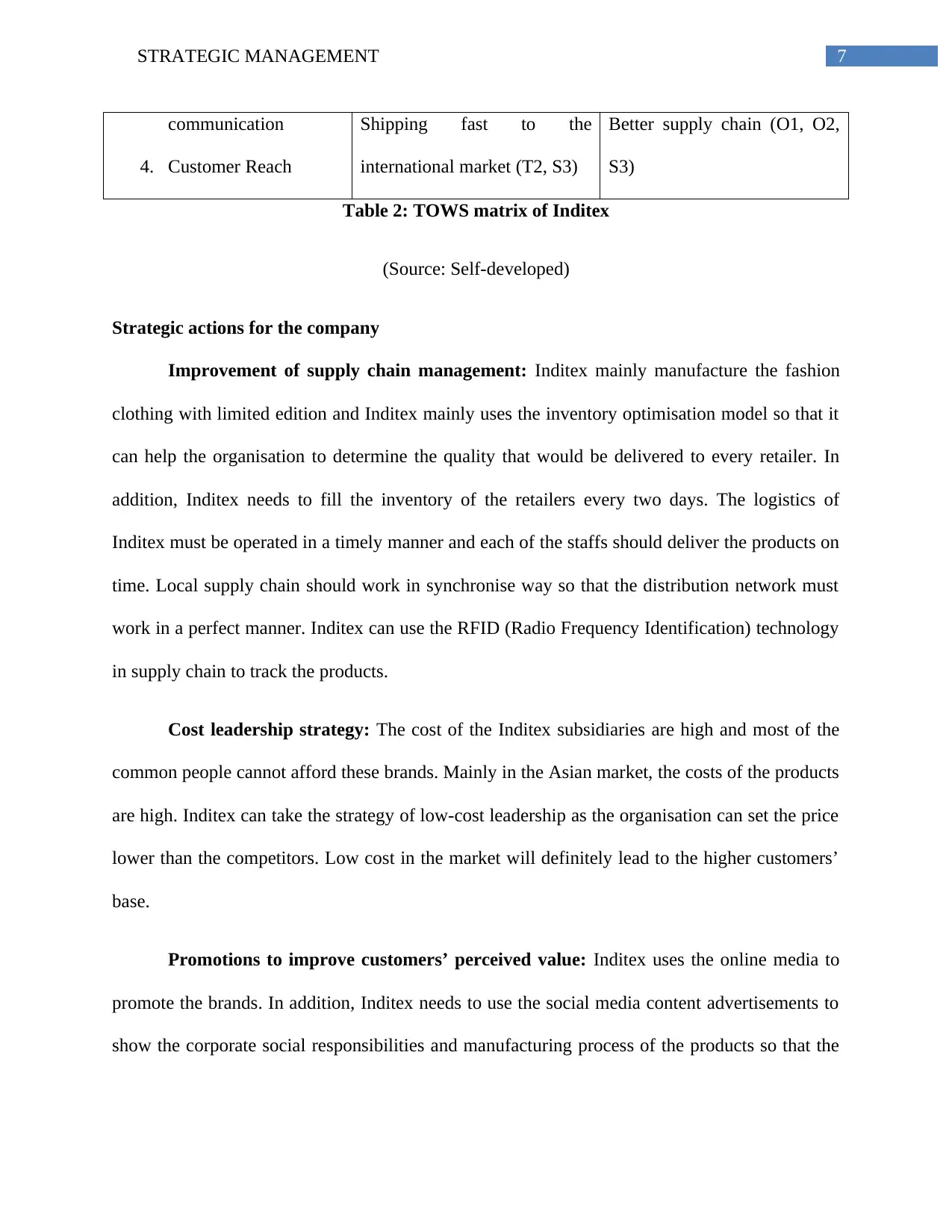
7STRATEGIC MANAGEMENT
communication
4. Customer Reach
Shipping fast to the
international market (T2, S3)
Better supply chain (O1, O2,
S3)
Table 2: TOWS matrix of Inditex
(Source: Self-developed)
Strategic actions for the company
Improvement of supply chain management: Inditex mainly manufacture the fashion
clothing with limited edition and Inditex mainly uses the inventory optimisation model so that it
can help the organisation to determine the quality that would be delivered to every retailer. In
addition, Inditex needs to fill the inventory of the retailers every two days. The logistics of
Inditex must be operated in a timely manner and each of the staffs should deliver the products on
time. Local supply chain should work in synchronise way so that the distribution network must
work in a perfect manner. Inditex can use the RFID (Radio Frequency Identification) technology
in supply chain to track the products.
Cost leadership strategy: The cost of the Inditex subsidiaries are high and most of the
common people cannot afford these brands. Mainly in the Asian market, the costs of the products
are high. Inditex can take the strategy of low-cost leadership as the organisation can set the price
lower than the competitors. Low cost in the market will definitely lead to the higher customers’
base.
Promotions to improve customers’ perceived value: Inditex uses the online media to
promote the brands. In addition, Inditex needs to use the social media content advertisements to
show the corporate social responsibilities and manufacturing process of the products so that the
communication
4. Customer Reach
Shipping fast to the
international market (T2, S3)
Better supply chain (O1, O2,
S3)
Table 2: TOWS matrix of Inditex
(Source: Self-developed)
Strategic actions for the company
Improvement of supply chain management: Inditex mainly manufacture the fashion
clothing with limited edition and Inditex mainly uses the inventory optimisation model so that it
can help the organisation to determine the quality that would be delivered to every retailer. In
addition, Inditex needs to fill the inventory of the retailers every two days. The logistics of
Inditex must be operated in a timely manner and each of the staffs should deliver the products on
time. Local supply chain should work in synchronise way so that the distribution network must
work in a perfect manner. Inditex can use the RFID (Radio Frequency Identification) technology
in supply chain to track the products.
Cost leadership strategy: The cost of the Inditex subsidiaries are high and most of the
common people cannot afford these brands. Mainly in the Asian market, the costs of the products
are high. Inditex can take the strategy of low-cost leadership as the organisation can set the price
lower than the competitors. Low cost in the market will definitely lead to the higher customers’
base.
Promotions to improve customers’ perceived value: Inditex uses the online media to
promote the brands. In addition, Inditex needs to use the social media content advertisements to
show the corporate social responsibilities and manufacturing process of the products so that the
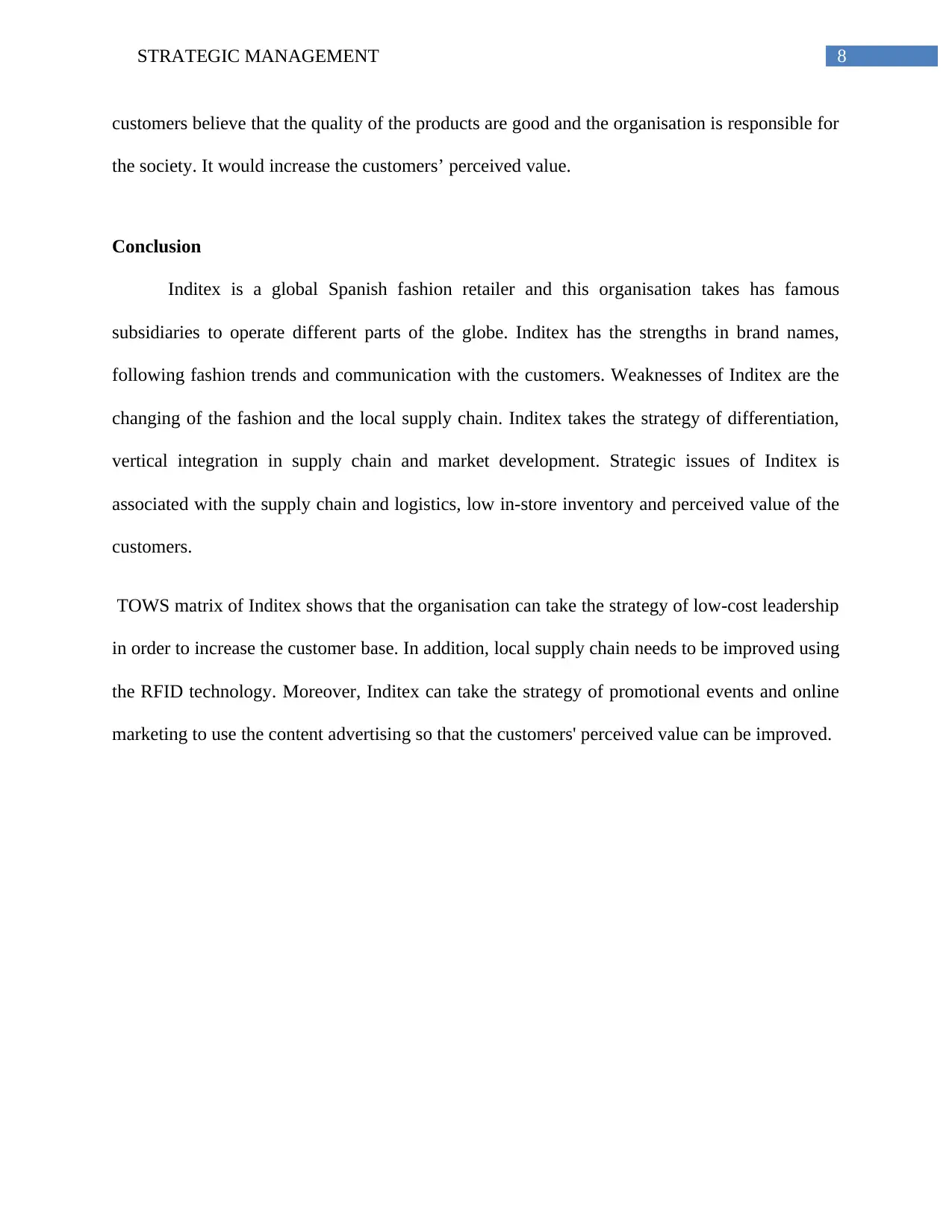
8STRATEGIC MANAGEMENT
customers believe that the quality of the products are good and the organisation is responsible for
the society. It would increase the customers’ perceived value.
Conclusion
Inditex is a global Spanish fashion retailer and this organisation takes has famous
subsidiaries to operate different parts of the globe. Inditex has the strengths in brand names,
following fashion trends and communication with the customers. Weaknesses of Inditex are the
changing of the fashion and the local supply chain. Inditex takes the strategy of differentiation,
vertical integration in supply chain and market development. Strategic issues of Inditex is
associated with the supply chain and logistics, low in-store inventory and perceived value of the
customers.
TOWS matrix of Inditex shows that the organisation can take the strategy of low-cost leadership
in order to increase the customer base. In addition, local supply chain needs to be improved using
the RFID technology. Moreover, Inditex can take the strategy of promotional events and online
marketing to use the content advertising so that the customers' perceived value can be improved.
customers believe that the quality of the products are good and the organisation is responsible for
the society. It would increase the customers’ perceived value.
Conclusion
Inditex is a global Spanish fashion retailer and this organisation takes has famous
subsidiaries to operate different parts of the globe. Inditex has the strengths in brand names,
following fashion trends and communication with the customers. Weaknesses of Inditex are the
changing of the fashion and the local supply chain. Inditex takes the strategy of differentiation,
vertical integration in supply chain and market development. Strategic issues of Inditex is
associated with the supply chain and logistics, low in-store inventory and perceived value of the
customers.
TOWS matrix of Inditex shows that the organisation can take the strategy of low-cost leadership
in order to increase the customer base. In addition, local supply chain needs to be improved using
the RFID technology. Moreover, Inditex can take the strategy of promotional events and online
marketing to use the content advertising so that the customers' perceived value can be improved.
⊘ This is a preview!⊘
Do you want full access?
Subscribe today to unlock all pages.

Trusted by 1+ million students worldwide
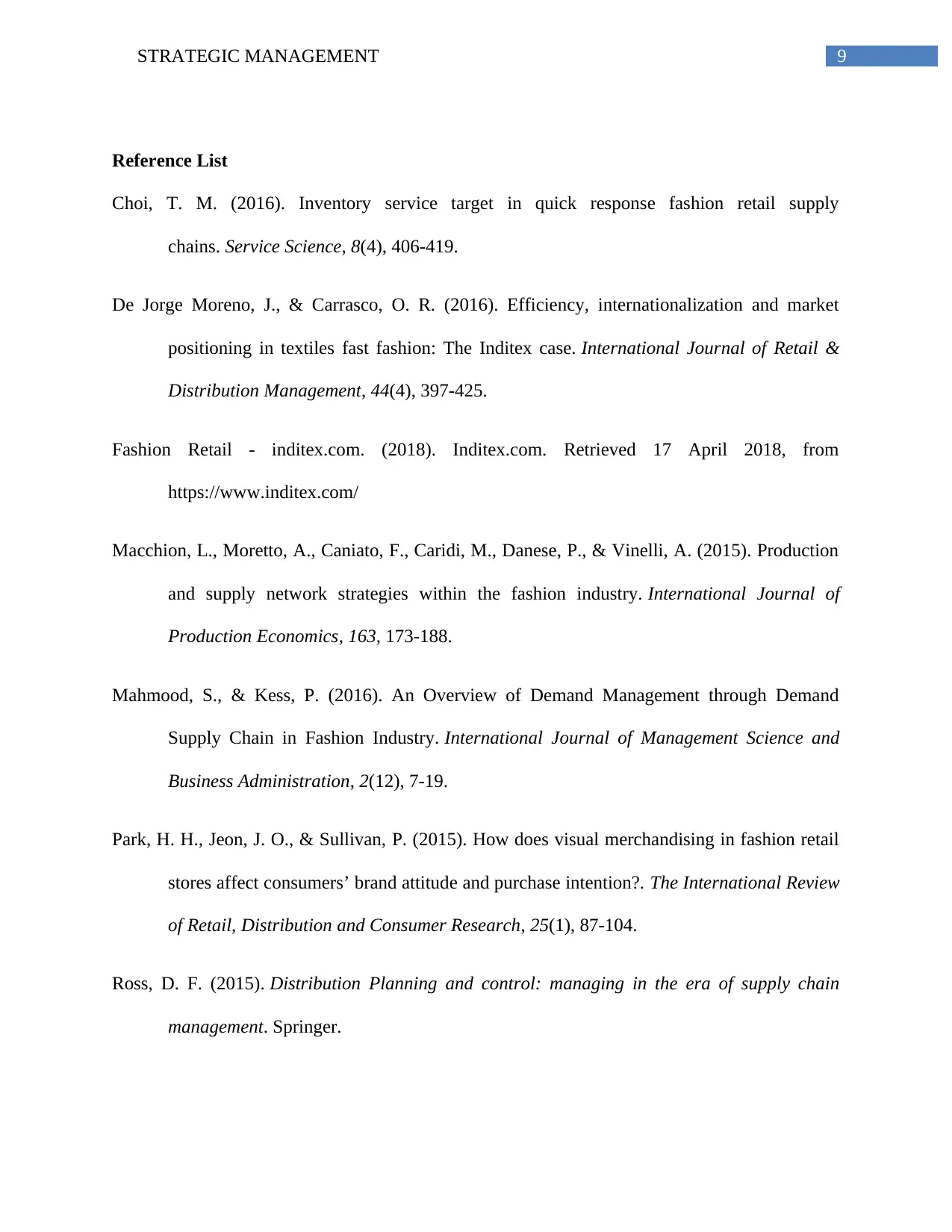
9STRATEGIC MANAGEMENT
Reference List
Choi, T. M. (2016). Inventory service target in quick response fashion retail supply
chains. Service Science, 8(4), 406-419.
De Jorge Moreno, J., & Carrasco, O. R. (2016). Efficiency, internationalization and market
positioning in textiles fast fashion: The Inditex case. International Journal of Retail &
Distribution Management, 44(4), 397-425.
Fashion Retail - inditex.com. (2018). Inditex.com. Retrieved 17 April 2018, from
https://www.inditex.com/
Macchion, L., Moretto, A., Caniato, F., Caridi, M., Danese, P., & Vinelli, A. (2015). Production
and supply network strategies within the fashion industry. International Journal of
Production Economics, 163, 173-188.
Mahmood, S., & Kess, P. (2016). An Overview of Demand Management through Demand
Supply Chain in Fashion Industry. International Journal of Management Science and
Business Administration, 2(12), 7-19.
Park, H. H., Jeon, J. O., & Sullivan, P. (2015). How does visual merchandising in fashion retail
stores affect consumers’ brand attitude and purchase intention?. The International Review
of Retail, Distribution and Consumer Research, 25(1), 87-104.
Ross, D. F. (2015). Distribution Planning and control: managing in the era of supply chain
management. Springer.
Reference List
Choi, T. M. (2016). Inventory service target in quick response fashion retail supply
chains. Service Science, 8(4), 406-419.
De Jorge Moreno, J., & Carrasco, O. R. (2016). Efficiency, internationalization and market
positioning in textiles fast fashion: The Inditex case. International Journal of Retail &
Distribution Management, 44(4), 397-425.
Fashion Retail - inditex.com. (2018). Inditex.com. Retrieved 17 April 2018, from
https://www.inditex.com/
Macchion, L., Moretto, A., Caniato, F., Caridi, M., Danese, P., & Vinelli, A. (2015). Production
and supply network strategies within the fashion industry. International Journal of
Production Economics, 163, 173-188.
Mahmood, S., & Kess, P. (2016). An Overview of Demand Management through Demand
Supply Chain in Fashion Industry. International Journal of Management Science and
Business Administration, 2(12), 7-19.
Park, H. H., Jeon, J. O., & Sullivan, P. (2015). How does visual merchandising in fashion retail
stores affect consumers’ brand attitude and purchase intention?. The International Review
of Retail, Distribution and Consumer Research, 25(1), 87-104.
Ross, D. F. (2015). Distribution Planning and control: managing in the era of supply chain
management. Springer.
Paraphrase This Document
Need a fresh take? Get an instant paraphrase of this document with our AI Paraphraser
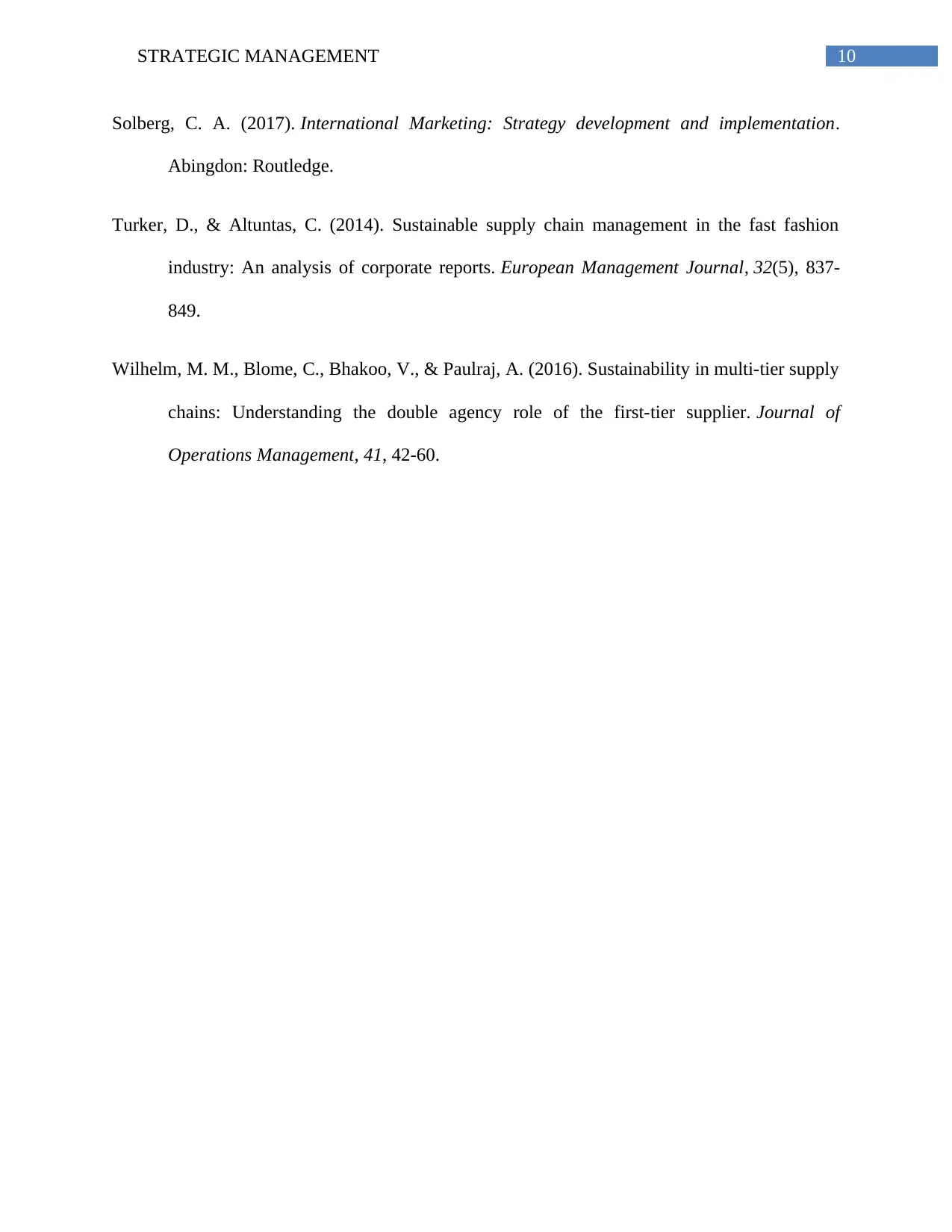
10STRATEGIC MANAGEMENT
Solberg, C. A. (2017). International Marketing: Strategy development and implementation.
Abingdon: Routledge.
Turker, D., & Altuntas, C. (2014). Sustainable supply chain management in the fast fashion
industry: An analysis of corporate reports. European Management Journal, 32(5), 837-
849.
Wilhelm, M. M., Blome, C., Bhakoo, V., & Paulraj, A. (2016). Sustainability in multi-tier supply
chains: Understanding the double agency role of the first-tier supplier. Journal of
Operations Management, 41, 42-60.
Solberg, C. A. (2017). International Marketing: Strategy development and implementation.
Abingdon: Routledge.
Turker, D., & Altuntas, C. (2014). Sustainable supply chain management in the fast fashion
industry: An analysis of corporate reports. European Management Journal, 32(5), 837-
849.
Wilhelm, M. M., Blome, C., Bhakoo, V., & Paulraj, A. (2016). Sustainability in multi-tier supply
chains: Understanding the double agency role of the first-tier supplier. Journal of
Operations Management, 41, 42-60.
1 out of 11
Related Documents
Your All-in-One AI-Powered Toolkit for Academic Success.
+13062052269
info@desklib.com
Available 24*7 on WhatsApp / Email
![[object Object]](/_next/static/media/star-bottom.7253800d.svg)
Unlock your academic potential
Copyright © 2020–2025 A2Z Services. All Rights Reserved. Developed and managed by ZUCOL.





